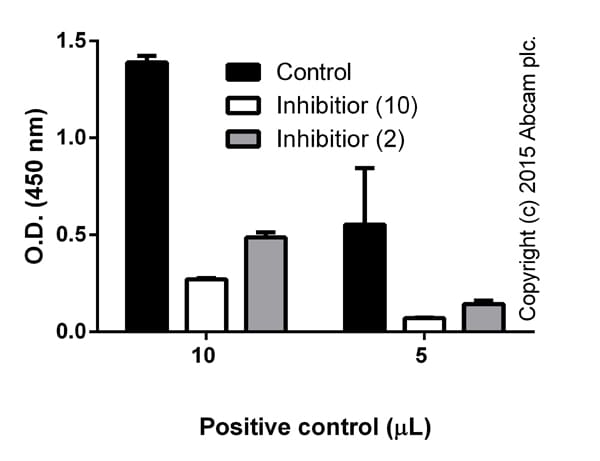SREBP-1 Transcription Factor Assay Kit (ab133125)
Key features and details
- Assay type: Semi-quantitative
- Detection method: Colorimetric
- Platform: Microplate reader
- Sample type: Cell culture extracts, Nuclear Extracts
Overview
-
Product name
SREBP-1 Transcription Factor Assay Kit -
Detection method
Colorimetric -
Sample type
Cell culture extracts, Nuclear Extracts -
Assay type
Semi-quantitative -
Species reactivity
Reacts with: Mouse, Rat, Human -
Product overview
Abcam's SREBP-1 Transcription Factor Assay (ab133125) is a non-radioactive, sensitive method for detecting specific transcription factor DNA binding activity in nuclear extracts.
A 96-well enzyme-linked immunosorbent assay (ELISA) replaces the cumbersome radioactive electrophoretic mobility shift assay (EMSA). A specific double stranded DNA (dsDNA) sequence containing the SREBP response element is immobilized onto the wells of a 96-well plate. SREBP-1 contained in a nuclear extract binds specifically to the SREBP response element. SREBP-1 is detected by addition of a specific primary antibody directed against SREBP-1. A secondary antibody conjugated to HRP is added to provide a sensitive colorimetric readout at 450 nm. The SREBP-1 Transcription Factor Assay detects human, rat, and murine SREBP-1.
-
Notes
Lipid homeostasis in vertebrate cells is regulated by a family of transcription factors called sterol regulatory elements binding proteins (SREBPs). SREBPs directly activate the expression of over 30 gened involved in teh synthesis and uptake of cholesterol, fatty cids, triglycerides and phopholipids. SREBP-1 acts primarily to activate genes in fatty acid synthesis. Nuclear SREBP-1 upregulates gene expression of a group of a target lipogenic enzymes such as acetyl CoA carboxylase and fatty acid synthase.
-
Platform
Microplate reader
Properties
-
Storage instructions
Please refer to protocols. -
Components 96 tests 96-Well Plate Cover 1 unit Polysorbate 20 1 vial SREBP-1 positive control 1 x 150µl SREBP-1 Primary Antibody 1 x 120µl Transcription Factor Antibody Binding Buffer (10X) 1 x 3ml Transcription Factor Binding Assay Buffer (4X) 1 x 3ml Transcription Factor Developing Solution 1 x 12ml Transcription Factor Goat Anti-Rabbit HRP Conjugate 1 x 100µl Transcription Factor Reagent A 1 x 120µl Transcription Factor SREBP 96-Well Strip Plate 1 unit Transcription Factor SREBP Competitor dsDNA 1 x 120µl Transcription Factor Stop Solution 1 x 12ml Wash Buffer Concentrate (400X) 1 x 5ml -
Research areas
- Epigenetics and Nuclear Signaling
- Transcription
- Domain Families
- HLH / Leucine Zipper
- HLH / Leucine Zipper
- Metabolism
- Pathways and Processes
- Metabolic signaling pathways
- Lipid and lipoprotein metabolism
- Lipid metabolism
-
Function
Transcriptional activator required for lipid homeostasis. Regulates transcription of the LDL receptor gene as well as the fatty acid and to a lesser degree the cholesterol synthesis pathway (By similarity). Binds to the sterol regulatory element 1 (SRE-1) (5'-ATCACCCCAC-3'). Has dual sequence specificity binding to both an E-box motif (5'-ATCACGTGA-3') and to SRE-1 (5'-ATCACCCCAC-3'). -
Tissue specificity
Expressed in a wide variety of tissues, most abundant in liver and adrenal gland. In fetal tissues lung and liver shows highest expression. Isoform SREBP-1C predominates in liver, adrenal gland and ovary, whereas isoform SREBP-1A predominates in hepatoma cell lines. Isoform SREBP-1A and isoform SREBP-1C are found in kidney, brain, white fat, and muscle. -
Sequence similarities
Belongs to the SREBP family.
Contains 1 basic helix-loop-helix (bHLH) domain. -
Post-translational
modificationsAt low cholesterol the SCAP/SREBP complex is recruited into COPII vesicles for export from the ER. In the Golgi complex SREBPs are cleaved sequentially by site-1 and site-2 protease. The first cleavage by site-1 protease occurs within the luminal loop, the second cleavage by site-2 protease occurs within the first transmembrane domain and releases the transcription factor from the Golgi membrane. Apoptosis triggers cleavage by the cysteine proteases caspase-3 and caspase-7.
Phosphorylated by AMPK, leading to suppress protein processing and nuclear translocation, and repress target gene expression. Phosphorylation at Ser-402 by SIK1 represses activity possibly by inhibiting DNA-binding. -
Cellular localization
Nucleus and Endoplasmic reticulum membrane. Golgi apparatus membrane. Cytoplasmic vesicle > COPII-coated vesicle membrane. Moves from the endoplasmic reticulum to the Golgi in the absence of sterols. - Information by UniProt
-
Alternative names
- ADD 1
- bHLHd1
- Class D basic helix-loop-helix protein 1
see all -
Database links
- Entrez Gene: 6720 Human
- Entrez Gene: 20787 Mouse
- Entrez Gene: 78968 Rat
- Omim: 184756 Human
- SwissProt: P36956 Human
- SwissProt: Q9WTN3 Mouse
- SwissProt: P56720 Rat
- Unigene: 592123 Human
see all
Images
-
HepG2 cells were grown in protein free hybridoma medium overnight (Life Technologies), followed by a 30 minutes incubation with the addition of 1% (2-Hydroxypropyl)-β-cyclodextrin (HPBC; Sigma) or with the supplement of liquid cholesterol (Life Technologies). 10 uL of nuclear extracts (ab113474) were tested, corresponding to 2.5e5 cells per well.
-
Positive control (10 or 5 uL) with (10 or 2 uL) or without inhibitor (duplicates; +/- SD).
-
Comparison of Abcam's SREBP-1 Transcription Factor Assay Kit (ab133125) and SREBP-2 Transcription Factor Assay Kit (ab133114) specificity. The results demonstrate little to no cross reactivity of SREBPs in the opposing assay. Cross Reactivity: (+) SREBP-1a, SREBP-1b, and SREBP-1c
-
Measurement of SREBP-1 activity in HeLa (squares) and HepG2 (dots) cell lysates.
-
Quantification of recombinant SREBP-1 from E. coli cell lysates.














